 W
WThe human shoulder is made up of three bones: the clavicle (collarbone), the scapula, and the humerus as well as associated muscles, ligaments and tendons. The articulations between the bones of the shoulder make up the shoulder joints. The shoulder joint, also known as the glenohumeral joint, is the major joint of the shoulder, but can more broadly include the acromioclavicular joint. In human anatomy, the shoulder joint comprises the part of the body where the humerus attaches to the scapula, and the head sits in the glenoid cavity. The shoulder is the group of structures in the region of the joint.
 W
WAdhesive capsulitis, also known as frozen shoulder, is a condition associated with shoulder pain and stiffness. There is a loss of the ability to move the shoulder, both voluntarily and by others, in multiple directions. The shoulder itself; however, does not generally hurt significantly when touched. Muscle loss around the shoulder may also occur. Onset is gradual over weeks to months. Complications can include fracture of the humerus or biceps tendon rupture.
 W
WAn ALPSA lesion is an injury at the front of the shoulder associated with shoulder dislocation.
 W
WThe clavicle, or collarbone, is a slender, S-shaped bone approximately 6 inches long bone that serves as a strut between the shoulder blade and the sternum (breastbone). There are two clavicles, one on the left and one on the right. The clavicle is the only long bone in the body that lies horizontally. Together with the shoulder blade, it makes up the shoulder girdle. It is a touchable bone, and in people who have less fat in this region, the location of the bone is clearly visible, as it creates a bulge in the skin. It receives its name from the Latin clavicula, because the bone rotates along its axis like a key when the shoulder is abducted. The clavicle is the most commonly fractured bone. It can easily be fractured due to impacts to the shoulder from the force of falling on outstretched arms or by a direct hit.
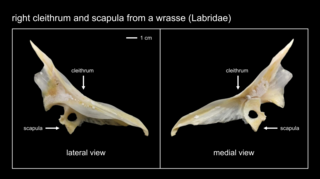 W
WThe cleithrum is a membrane bone which first appears as part of the skeleton in primitive bony fish, where it runs vertically along the scapula. Its name is derived from Greek κλειθρον = "key (lock)", by analogy with "clavicle" from Latin clavicula = "little key".
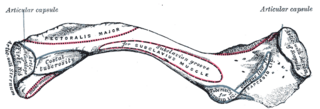 W
WOn the medial part of the clavicle is a broad rough surface, the costal tuberosity, rather more than 2 cm. in length, for the attachment of the costoclavicular ligament.
 W
WA dislocated shoulder is when the head of the humerus is out of the shoulder joint. Symptoms include shoulder pain and instability. Complications may include a Bankart lesion, Hill-Sachs lesion, rotator cuff tear, or injury to the axillary nerve.
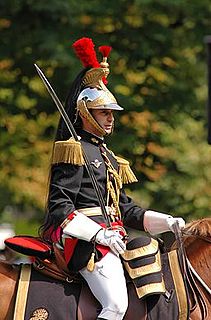 W
WEpaulette is a type of ornamental shoulder piece or decoration used as insignia of rank by armed forces and other organizations. In the French and other armies, epaulettes are also worn by all ranks of elite or ceremonial units when on parade. It may bear rank or other insignia, and should not be confused with a shoulder mark – also called a shoulder board, rank slide, or slip-on – a flat cloth sleeve worn on the shoulder strap of a uniform.
 W
WThe glenoid cavity or glenoid fossa of scapula is a part of the shoulder. It is a shallow, pyriform articular surface, which is located on the lateral angle of the scapula. It is directed laterally and forward and articulates with the head of the humerus; it is broader below than above and its vertical diameter is the longest.
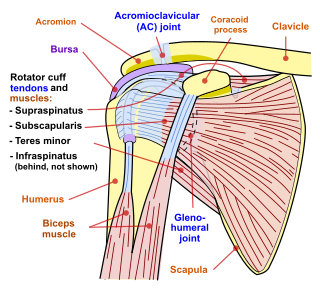 W
WShoulder impingement syndrome is a syndrome involving tendonitis of the rotator cuff muscles as they pass through the subacromial space, the passage beneath the acromion. It is particularly associated with tendonitis of the supraspinatus muscle. This can result in pain, weakness, and loss of movement at the shoulder.
 W
WThe infraspinatous fossa of the scapula is much larger than the supraspinatous fossa; toward its vertebral margin a shallow concavity is seen at its upper part; its center presents a prominent convexity, while near the axillary border is a deep groove which runs from the upper toward the lower part.
 W
WQuadrilateral space syndrome is a rotator cuff denervation syndrome in which the axillary nerve is compressed at the quadrilateral space of the rotator cuff.
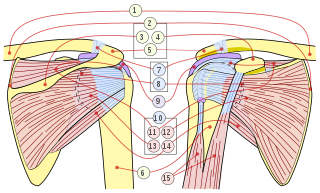 W
WIn anatomy, the rotator cuff is a group of muscles and their tendons that act to stabilize the shoulder and allow for its extensive range of motion. Of the seven scapulohumeral muscles, four make up the rotator cuff. The four muscles are the supraspinatus muscle, the infraspinatus muscle, teres minor muscle, and the subscapularis muscle.
 W
WA rotator cuff tear is an injury where one or more of the tendons or muscles of the rotator cuff of the shoulder get torn. Symptoms may include shoulder pain, which is often worse with movement, or weakness. This may limit people’s ability to brush their hair or put on clothing. Clicking may also occur with movement of the arm.
 W
WIn anatomy, the scapula, also known as the shoulder bone, shoulder blade, wing bone or blade bone, is the bone that connects the humerus with the clavicle. Like their connected bones, the scapulae are paired, with each scapula on either side of the body being roughly a mirror image of the other. The name derives from the Classical Latin word for trowel or small shovel, which it was thought to resemble.
 W
WA separated shoulder, also known as acromioclavicular joint injury, is a common injury to the acromioclavicular joint. The AC joint is located at the outer end of the clavicle where it attaches to the acromion of the scapula. Symptoms include pain which may make it difficult to move the shoulder and often a deformity.
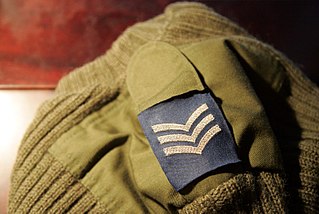 W
WA shoulder mark, also called a shoulder board, rank slide, or slip-on, is a flat cloth sleeve worn on the shoulder strap of a uniform. It may bear rank or other insignia, and should not be confused with an epaulette, although the two terms are often used interchangeably.
 W
WShoulder pads are a piece of protective equipment used in many contact sports such as gridiron football, lacrosse and hockey. Most modern shoulder pads consist of a shock absorbing foam material with a hard plastic outer covering. The pieces are usually secured by rivets or strings that the user can tie to adjust the size.
 W
WShoulder problems including pain, are one of the more common reasons for physician visits for musculoskeletal symptoms. The shoulder is the most movable joint in the body. However, it is an unstable joint because of the range of motion allowed. This instability increases the likelihood of joint injury, often leading to a degenerative process in which tissues break down and no longer function well.
 W
WThe traditional prayer in honor of the Shoulder Wound of Jesus calls to mind the Wound He is said to have received carrying His Cross. It is variously attributed to Saint Bernard of Clairvaux or to St. Gertrude or St. Mechtilde.
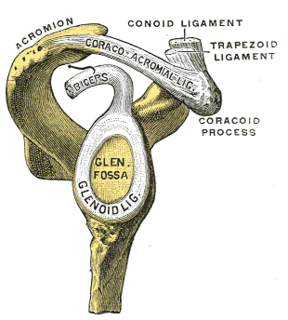 W
WA SLAP tear or SLAP lesion is an injury to the glenoid labrum. SLAP is an acronym for "superior labral tear from anterior to posterior".
 W
WThe subcoracoid bursa or subcoracoid bursa of Collas is a synovial bursa located in the shoulder.
 W
WThe supra-acromial bursa is located on the superior aspect of the acromion and normally does not communicate with the glenohumeral joint. Supra-acromial bursitis has not been receiving much attention from literature and remains described mainly as case reports of presumptive diagnosis with no histopathological correlation. Since the bursa is supra-acromial, not supraclavicular, fluid-filled masses located over the acromioclavicular joint or distal clavicle do not correspond to supra-acromial bursitis.
 W
WThe suprascapular canal is an anatomical passage between two openings found on the upper dorsal aspect of the shoulder. It is found bilaterally running on superio-lateral aspect of the dorsal surface of the scapula underneath the supraspinatus muscle.
 W
WThe suprascapular notch is a notch in the superior border of the scapula, just medial to the base of the coracoid process.